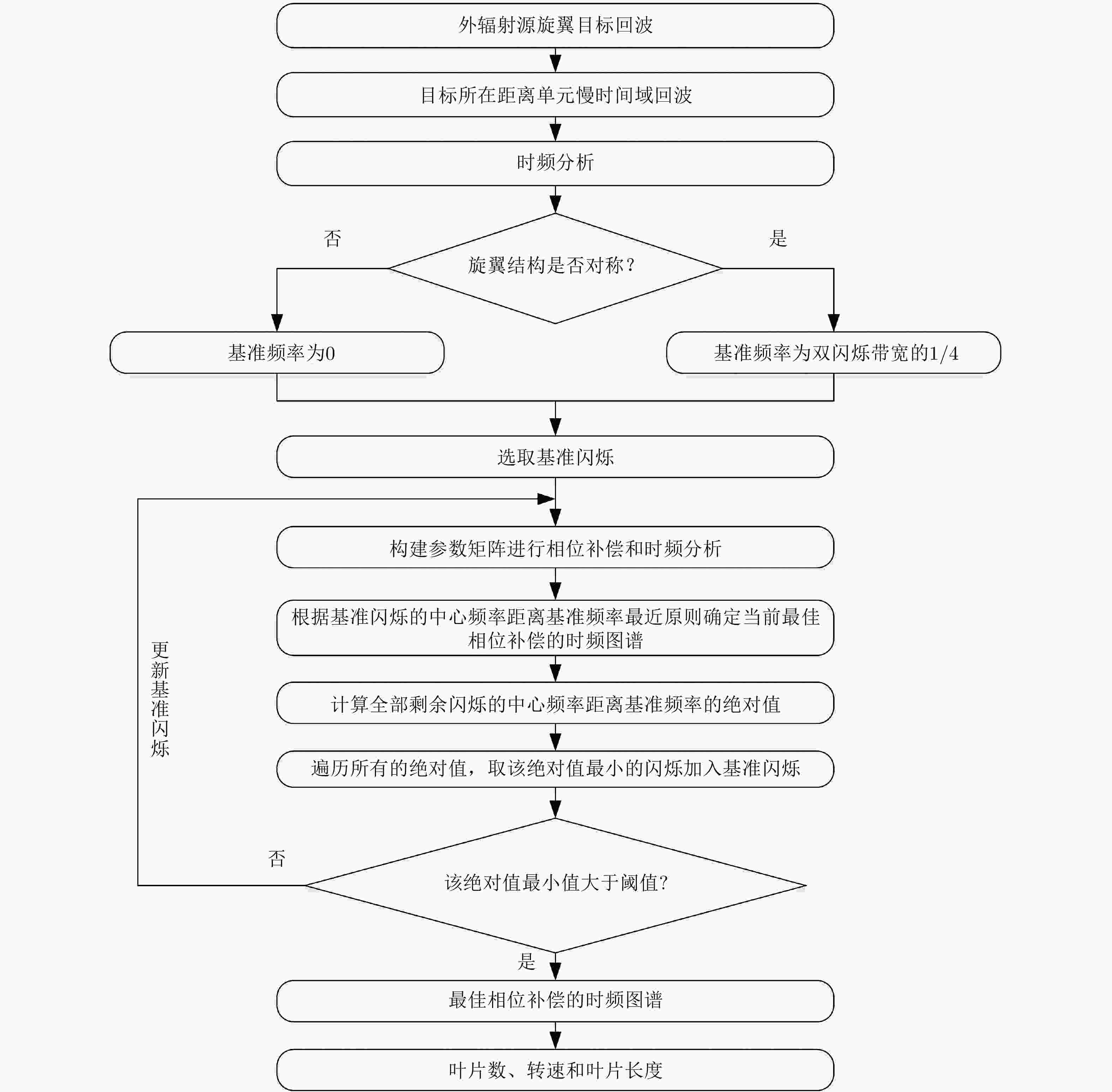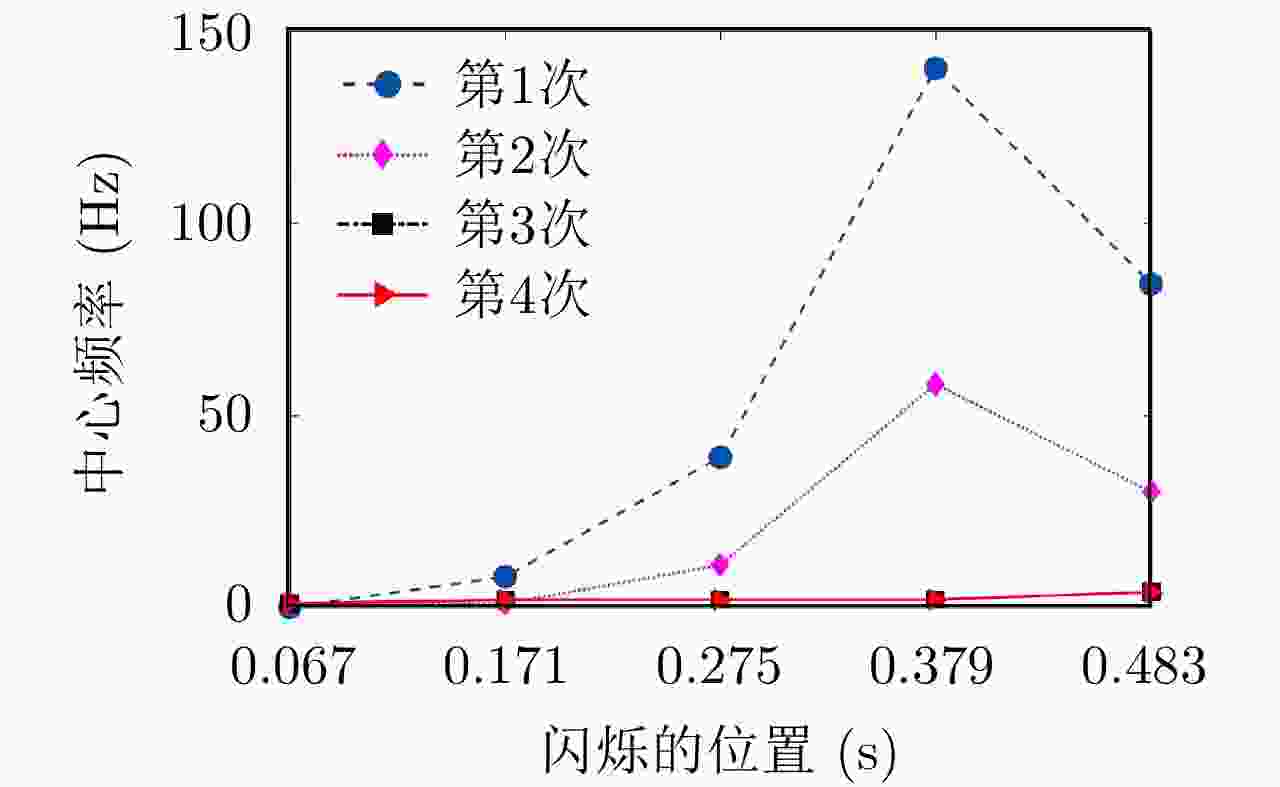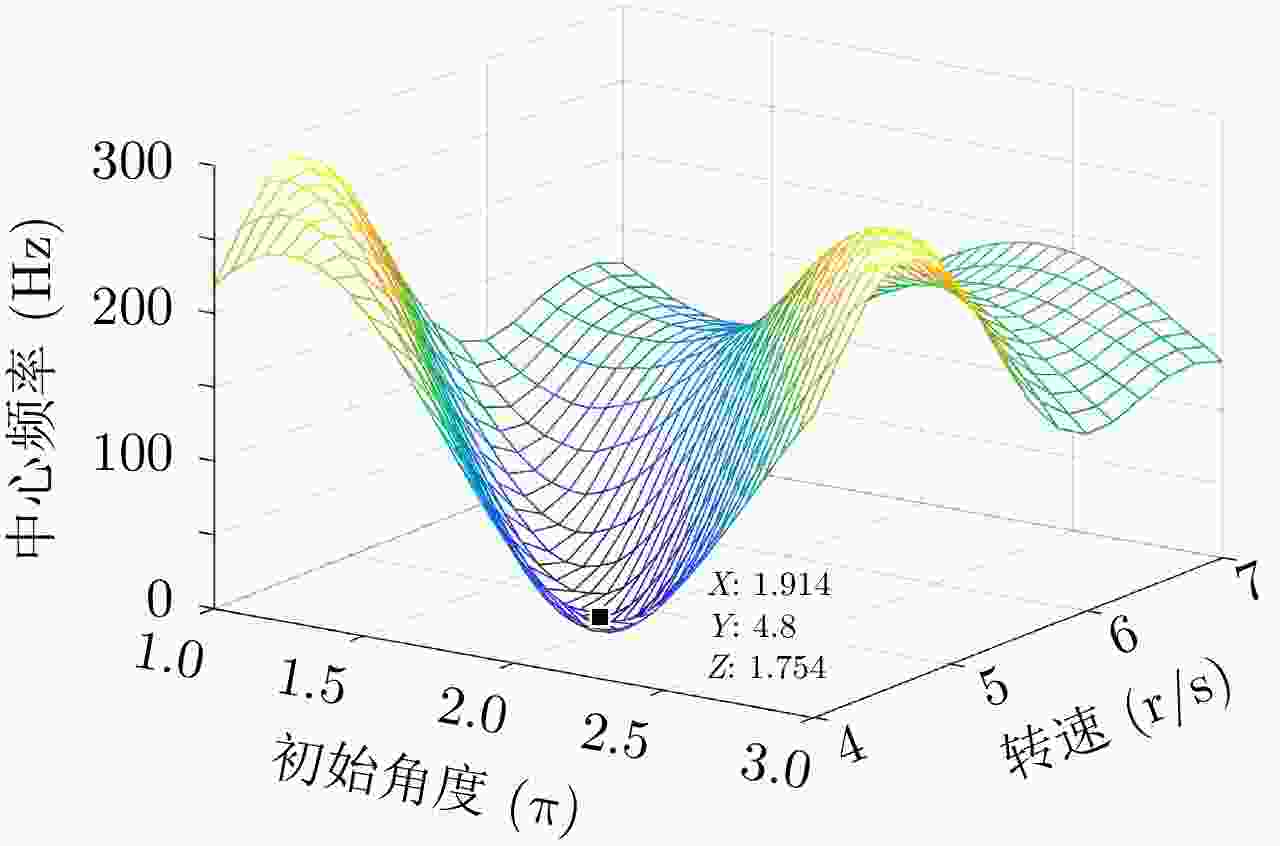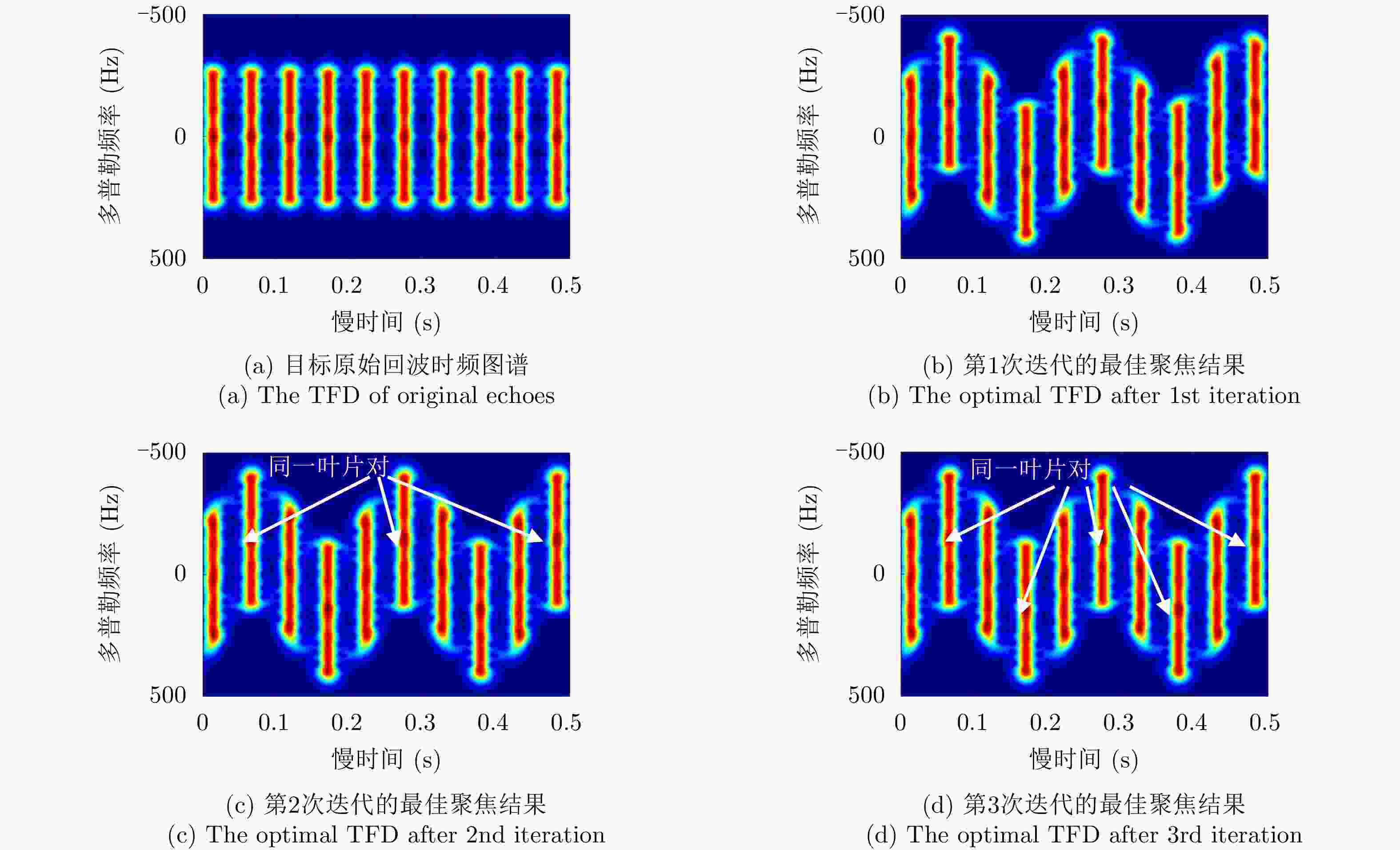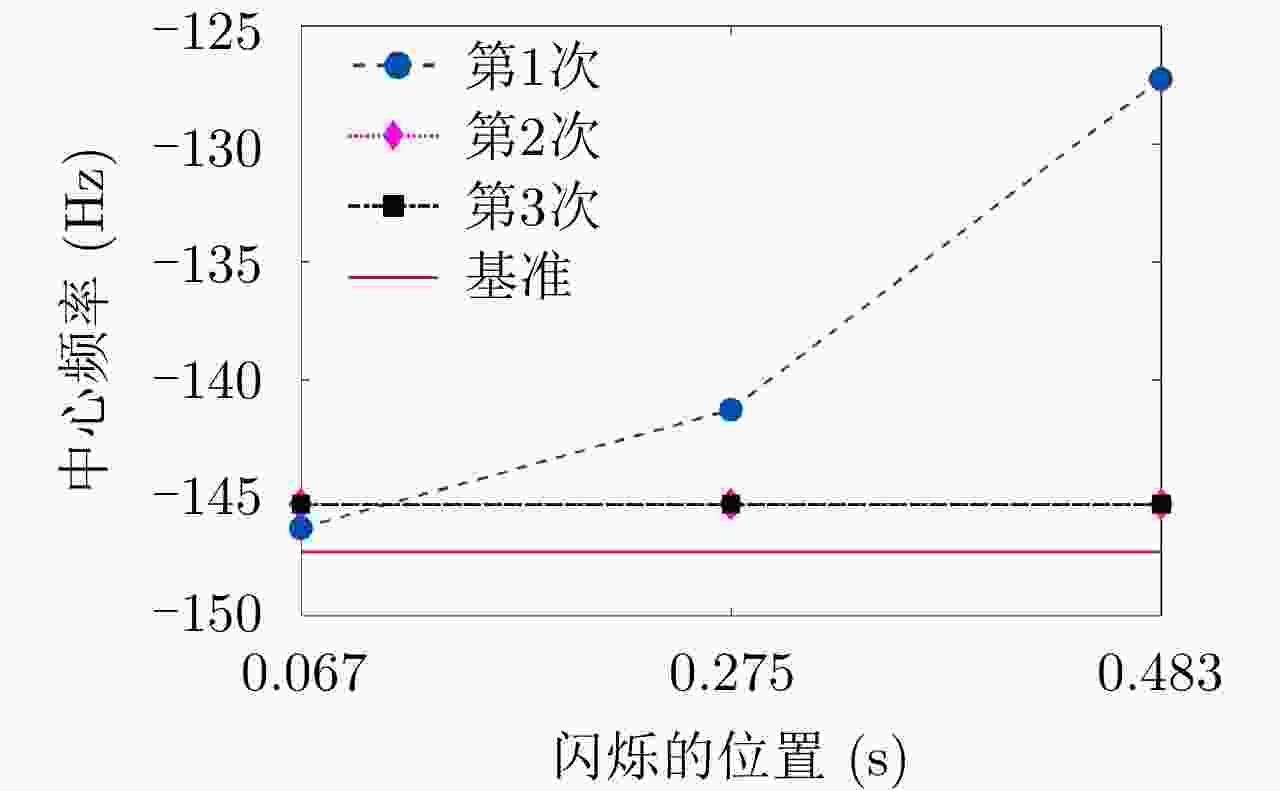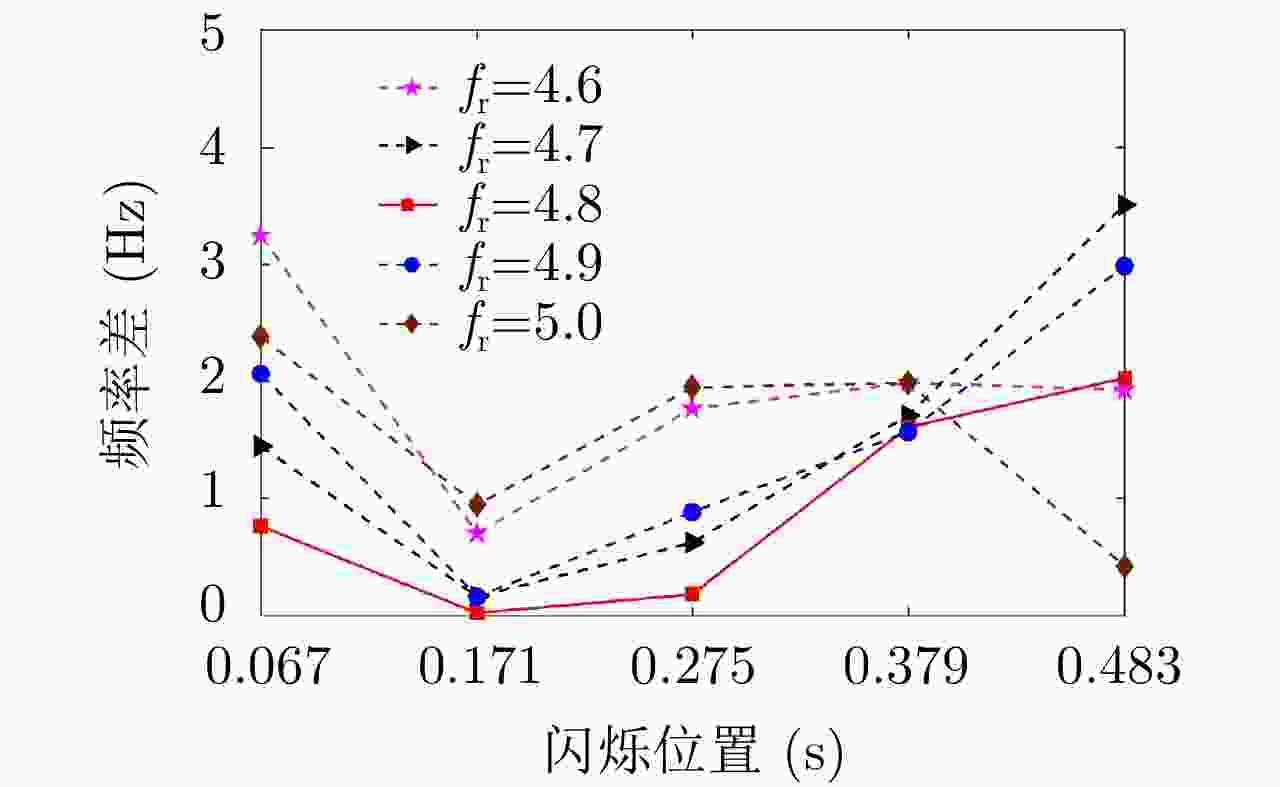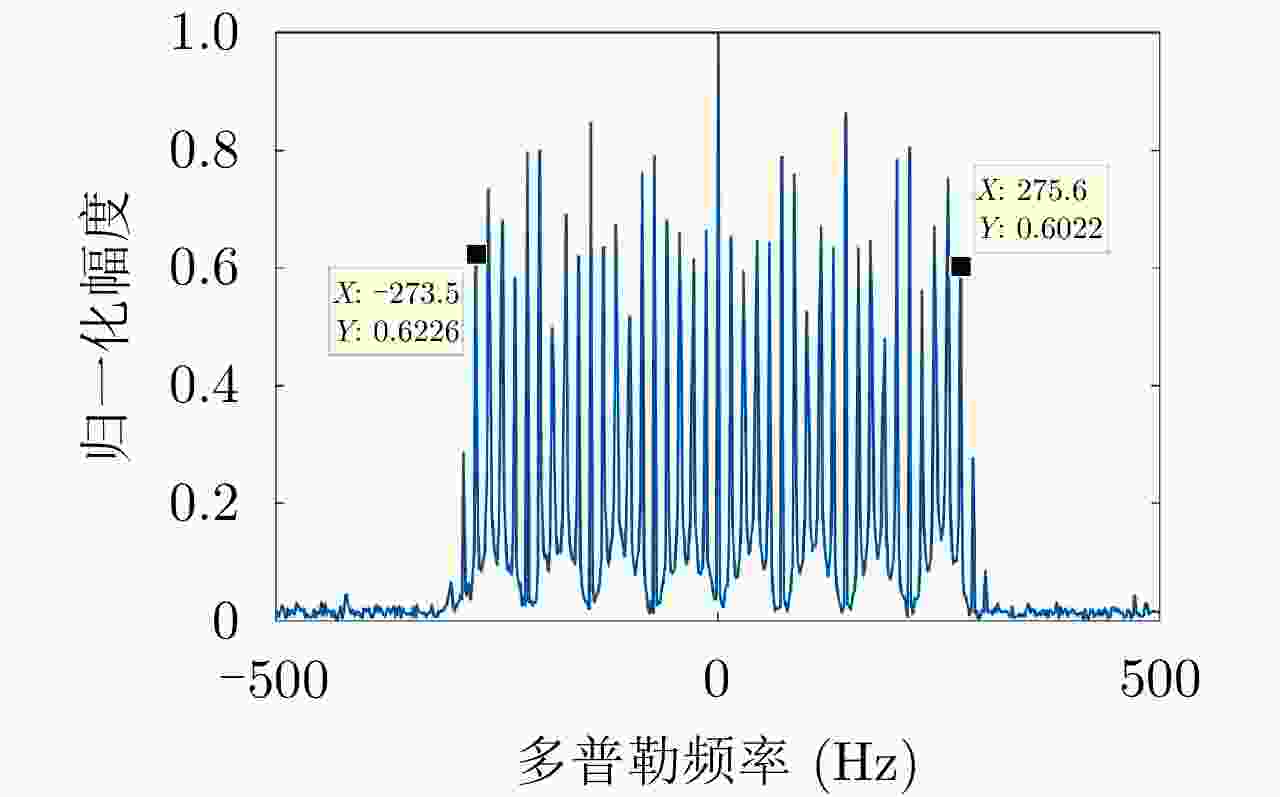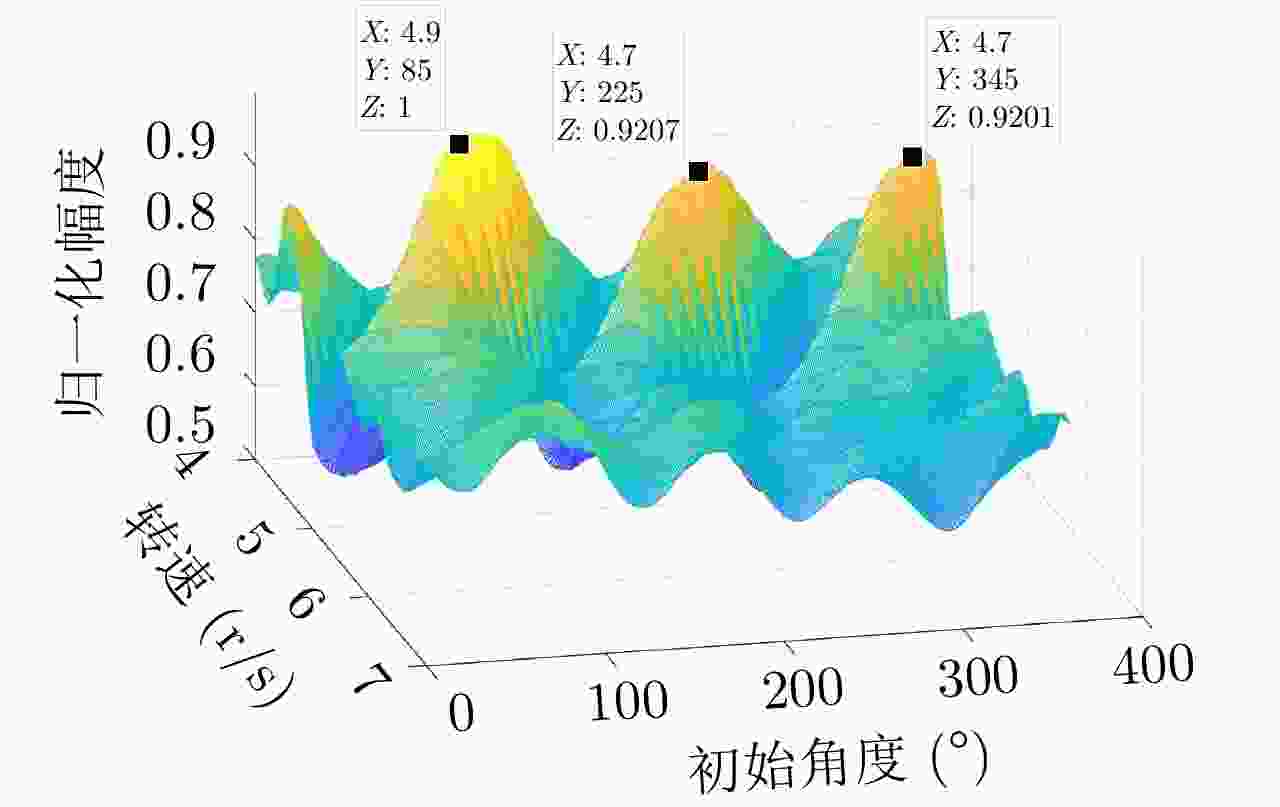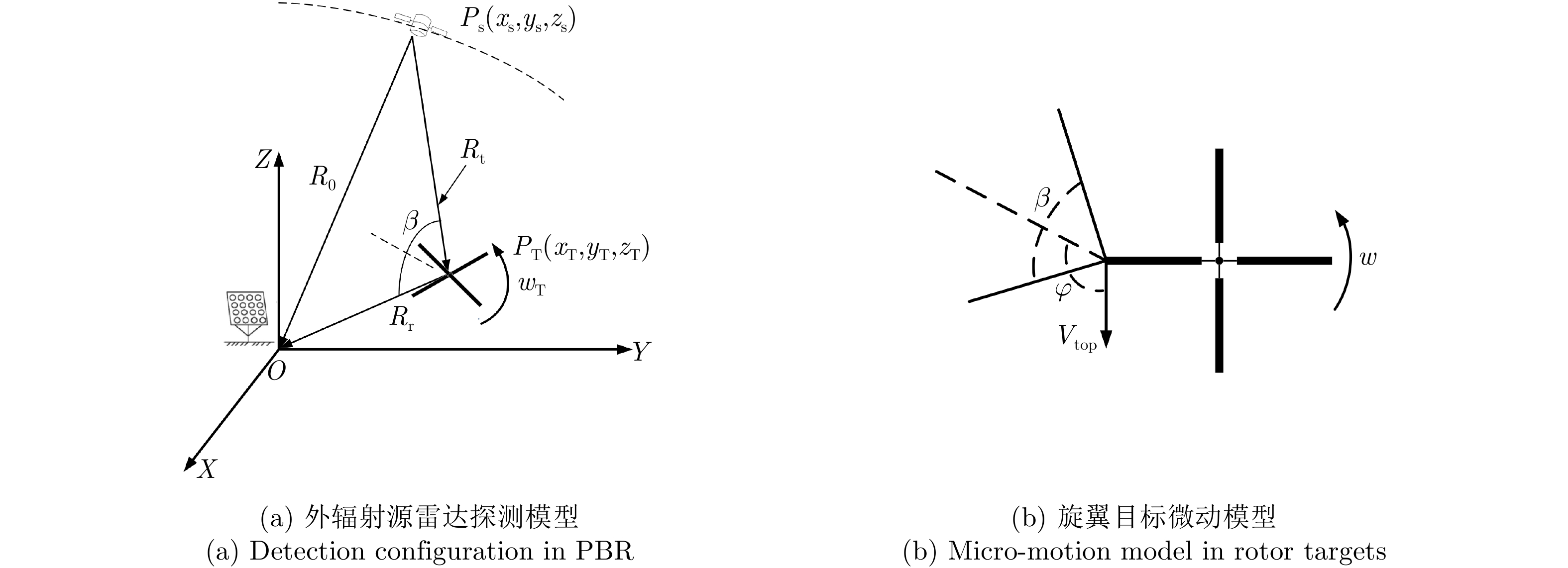Feature Extraction of Rotor Blade Targets Based on Phase Compensation in a Passive Bistatic Radar
-
摘要: 全球定位导航系统(GNSS)作为一种覆盖广泛的稳定信号源,对于微动目标特性识别具有相当大的实用价值。针对外辐射源旋翼目标识别问题,该文提出基于相位补偿的旋翼特征提取新思路。通过分析旋翼目标时频域内闪烁分布的数学形成机理,提出利用相位补偿的方法将相同叶片的闪烁聚焦到特定多普勒频率,进而估计旋翼的叶片数。然后依据闪烁中心频率距离基准频率最近的原则从参数矩阵中估计叶片转速等参数,并利用闪烁占据的带宽计算叶片的长度。最后仿真实验结果验证该方法对参数空间设置的适用性更强,估计精度也更高,并且可以在回波域实现旋翼目标的叶片分离。Abstract: As a stable and widely covered signal resource, a Global Navigation Satellite System (GNSS) plays an important part in micro-Doppler extraction in a near field. This paper aims at the problems associated with rotor blade target recognition and proposes a novel solution based on phase compensation. First, the mathematical mechanism of flicker distribution in a time-frequency field is analyzed, and phase compensation is used to achieve the Doppler focusing, and then the blade number can be estimated. Second, according to the that the minimum delta frequency principle between the center frequency and standard frequency, the rotation velocity of the rotor blade is obtained. Next, blade lengths can be calculated through the flicker bandwidth in the time-frequency domain. Finally, the simulation experiments validate the effectiveness of the proposed method.
-
Key words:
- Passive bistatic radar /
- Micro-motion /
- Time-frequency flicker /
- Phase compensation /
- Center frequency
-
表 1 仿真实验参数
Table 1. The parameters in simulation experiments
参数 数值 频段 1575.42 MHz 叶片数 3, 4 叶片长度 7.3 m 旋转速率fr 4.8 r/s 信噪比 –10 dB 采样率 2.046 MHz 表 2 非对称旋翼结构基准闪烁的更新
Table 2. The update of standard flashes in asymmetry rotor target
迭代次数 基准闪烁位置 1 (0.067 s) 2 (0.067 s, 0.171 s) 3 (0.067 s, 0.171 s, 0.275 s) 4 (0.067 s, 0.171 s, 0.275 s, 0.379 s) 表 3 对称旋翼结构基准闪烁的更新
Table 3. The update of standard flashes in symmetry rotor target
迭代次数 基准闪烁/位置 1 (0.067 s) 2 (0.067 s, 0.275 s) 3 (0.067 s, 0.275 s, 0.483 s) 表 4 OMP算法实验条件
Table 4. The experiment condition of OMP algorithm
方法 叶片数 叶片长度L (m) 初相角 (°) 实验a 1, 3, 5, 7 5:0.01:8 0:2.4:120 实验b 1, 3, 5, 7 6:0.01:8 0:2.4:120 实验c 1, 3, 5, 7 6:0.01:8 0:12:120 表 5 参数估计结果对比
Table 5. The parameter estimation result of different algorithms
方法 叶片数$ \hat Q $ (个) 长度$ \hat L $ (m) 角速度$ \hat w $ (rad/s) 本方法,Q=3 3 7.34 $ 2\pi \times 4.80 $ 本方法,Q=4 4 7.38 $ 2\pi \times 4.80 $ Hough,Q=3 3 7.35 $ 2\pi \times 4.77 $ OMP,实验a 无效 5.82 $ 2\pi \times 11.21 $ OMP,实验b 3 7.45 $ 2\pi \times 4.80 $ OMP,实验c 无效 7.05 $ 2\pi \times 6.73 $ -
[1] 曹伟. LTE外辐射源雷达多旋翼无人机探测技术研究[D]. [博士论文], 国防科学技术大学, 2018.CAO Wei. Research of multi-rotor UAV detection techniques based on LTE passive radar[D]. [Ph. D. dissertation], National University of Defense Technology, 2018. [2] KUSCHEL H, CRISTALLINI D, and OLSEN K E. Tutorial: Passive radar tutorial[J]. IEEE Aerospace and Electronic Systems Magazine, 2019, 34(2): 2–19. doi: 10.1109/MAES.2018.160146 [3] LI Kaiming, QU Xiaoyu, WU Yong, et al. A method for Micro-Doppler extraction under passive radar based on communiction signal[C]. IGARSS 2019 - 2019 IEEE International Geoscience and Remote Sensing Symposium, Yokohama, Japan, 2019: 3760–3763. [4] 张群, 胡健, 罗迎, 等. 微动目标雷达特征提取、成像与识别研究进展[J]. 雷达学报, 2018, 7(5): 531–547. doi: 10.12000/JR18049ZHANG Qun, HU Jian, LUO Ying, et al. Research progresses in radar feature extraction, imaging, and recognition of target with micro-motions[J]. Journal of Radars, 2018, 7(5): 531–547. doi: 10.12000/JR18049 [5] ZHANG Wenyu, LI Gang, and BAKER C. Radar recognition of multiple micro-drones based on their Micro-Doppler signatures via dictionary learning[J]. IET Radar, Sonar & Navigation, 2020, 14(9): 1310–1318. doi: 10.1049/iet-rsn.2019.0225 [6] CRESPO-BALLESTEROS M, ANTONIOU M, and CHERNIAKOV M. Wind turbine blade radar signatures in the near field: Modeling and experimental confirmation[J]. IEEE Transactions on Aerospace and Electronic Systems, 2017, 53(4): 1916–1931. doi: 10.1109/TAES.2017.2675241 [7] 马娇, 董勇伟, 李原, 等. 多旋翼无人机微多普勒特性分析与特征提取[J]. 中国科学院大学学报, 2019, 36(2): 235–243. doi: 10.7523/j.issn.2095-6134.2019.02.011MA Jiao, DONG Yongwei, LI Yuan, et al. Multi-rotor UAV’s micro-Doppler characteristic analysis and feature extraction[J]. Journal of University of Chinese Academy of Sciences, 2019, 36(2): 235–243. doi: 10.7523/j.issn.2095-6134.2019.02.011 [8] 宋子龙, 李开明, 张群, 等. 基于PC-OFDM信号外辐射源雷达的低空旋翼目标微动特征提取[J]. 电光与控制, 2021, 28(7): 26–30. doi: 10.3969/j.issn.1671-637X.2021.07.006SONG Zilong, LI Kaiming, ZHANG Qun, et al. Micro-motion feature extraction of low-altitude rotor target based on PC-OFDM passive radar[J]. Electronics Optics &Control, 2021, 28(7): 26–30. doi: 10.3969/j.issn.1671-637X.2021.07.006 [9] 占伟杰, 万显荣, 易建新, 等. 外辐射源雷达目标扇叶微多普勒效应实验研究[J]. 系统工程与电子技术, 2021, 43(6): 1468–1476. doi: 10.12305/j.issn.1001-506X.2021.06.03ZHAN Weijie, WAN Xianrong, YI Jianxin, et al. Experimental study on micro-Doppler effect of target blades in passive radar[J]. Systems Engineering and Electronics, 2021, 43(6): 1468–1476. doi: 10.12305/j.issn.1001-506X.2021.06.03 [10] 陈小龙, 南钊, 张海, 等. 飞鸟与旋翼无人机雷达微多普勒测量实验研究[J]. 电波科学学报, 2021, 36(5): 704–714. doi: 10.12265/j.cjors.2020192CHEN Xiaolong, NAN Zhao, ZHANG Hai, et al. Experimental research on radar micro-Doppler of flying bird and rotor UAV[J]. Chinese Journal of Radio Science, 2021, 36(5): 704–714. doi: 10.12265/j.cjors.2020192 [11] 陈小龙, 陈唯实, 饶云华, 等. 飞鸟与无人机目标雷达探测与识别技术进展与展望[J]. 雷达学报, 2020, 9(5): 803–827. doi: 10.12000/JR20068CHEN Xiaolong, CHEN Weishi, RAO Yunhua, et al. Progress and prospects of radar target detection and recognition technology for flying birds and unmanned aerial vehicles[J]. Journal of Radars, 2020, 9(5): 803–827. doi: 10.12000/JR20068 [12] CLEMENTE C and SORAGHAN J J. GNSS-based passive bistatic radar for micro-Doppler analysis of helicopter rotor blades[J]. IEEE Transactions on Aerospace and Electronic Systems, 2014, 50(1): 491–500. doi: 10.1109/TAES.2013.120018 [13] 朱名烁, 韦旭, 周毅恒, 等. 旋翼类目标雷达回波建模及对微动特性影响分析[J]. 中国电子科学研究院学报, 2019, 14(10): 1068–1076. doi: 10.3969/j.issn.1673-5692.2019.10.013ZHU Mingshuo, WEI Xu, ZHOU Yiheng, et al. Rotor targets radar echo modeling and its influence on micro-motion characteristics[J]. Journal of CAEIT, 2019, 14(10): 1068–1076. doi: 10.3969/j.issn.1673-5692.2019.10.013 [14] 陈永彬, 李少东, 杨军, 等. 旋翼叶片回波建模与闪烁现象机理分析[J]. 物理学报, 2016, 65(13): 138401. doi: 10.7498/aps.65.138401CHEN Yongbin, LI Shaodong, YANG Jun, et al. Rotor blades echo modeling and mechanism analysis of flashes phenomena[J]. Acta Physica Sinica, 2016, 65(13): 138401. doi: 10.7498/aps.65.138401 [15] LIU Jin, AI Xiaofeng, ZHAO Feng, et al. Motion estimation of micro-motion targets with translational motion[C]. IET International Radar Conference 2015, Hangzhou, China, 2015: 1–5. [16] 李宇倩, 易建新, 万显荣, 等. 外辐射源雷达直升机旋翼参数估计方法[J]. 雷达学报, 2018, 7(3): 313–319. doi: 10.12000/JR17125LI Yuqian, YI Jianxin, WAN Xianrong, et al. Helicopter rotor parameter estimation method for passive radar[J]. Journal of Radars, 2018, 7(3): 313–319. doi: 10.12000/JR17125 [17] 张群, 屈筱钰, 李开明, 等. MMV模型下无源双基雷达低空目标微动特征提取[J]. 华中科技大学学报:自然科学版, 2020, 48(3): 69–74. doi: 10.13245/j.hust.200313ZHANG Qun, QU Xiaoyu, LI Kaiming, et al. Micro-Doppler feature extraction of low-altitude targets based on MMV model under passive bistasic radar[J]. Journal of Huazhong University of Science and Technology:Natural Science Edition, 2020, 48(3): 69–74. doi: 10.13245/j.hust.200313 [18] 夏赛强, 向虎, 陈文峰, 等. 基于CEMD的旋翼微动目标杂波抑制方法[J]. 航空学报, 2018, 39(9): 322082. doi: 10.7527/S1000-6893.2018.22082XIA Saiqiang, XIANG Hu, CHEN Wenfeng, et al. Clutter suppression method for rotor micro-motion target based on CEMD[J]. Acta Aeronautica et Astronautica Sinica, 2018, 39(9): 322082. doi: 10.7527/S1000-6893.2018.22082 [19] XIA Saiqiang, YANG Jun, CAI Wanyong, et al. Adaptive complex variational mode decomposition for micro-motion signal processing applications[J]. Sensors, 2021, 21(5): 1637. doi: 10.3390/s21051637 -



 作者中心
作者中心 专家审稿
专家审稿 责编办公
责编办公 编辑办公
编辑办公
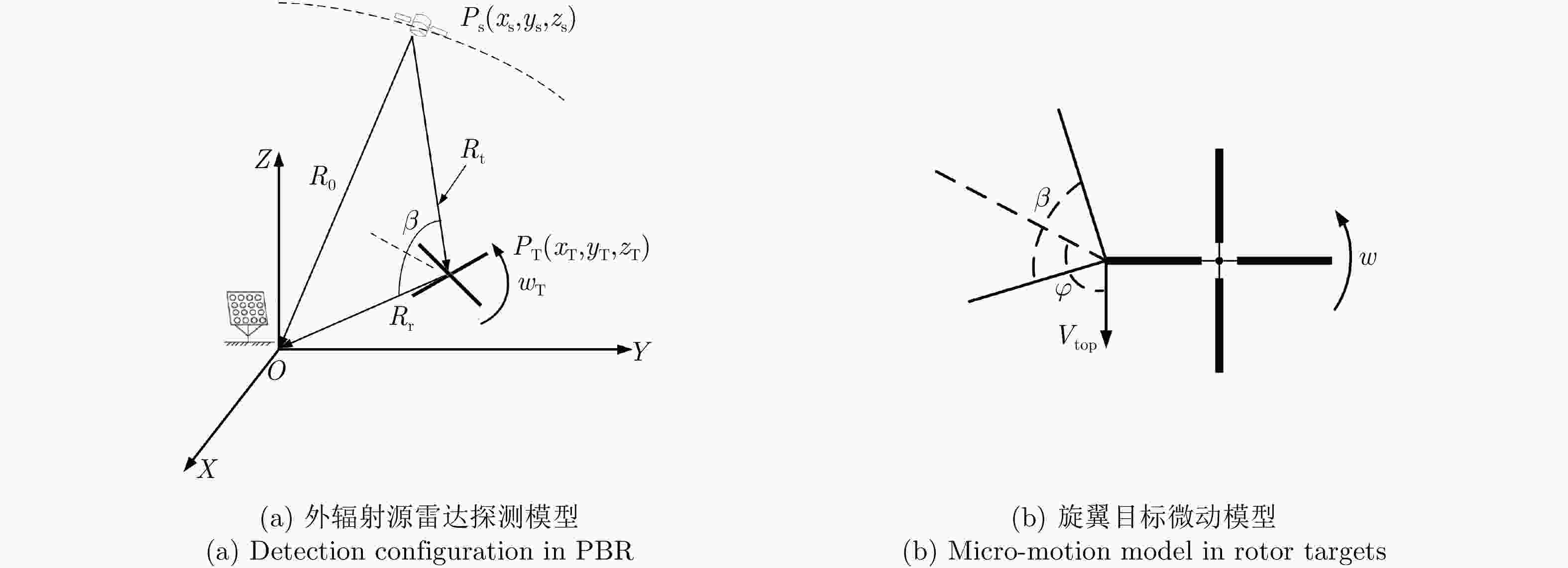
 下载:
下载:


